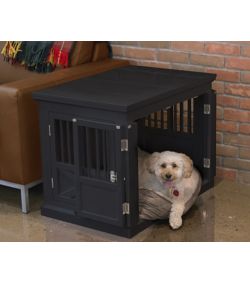How a Crate can Make Your Malamute more Secure and Happy
(the 7 states of separation grief)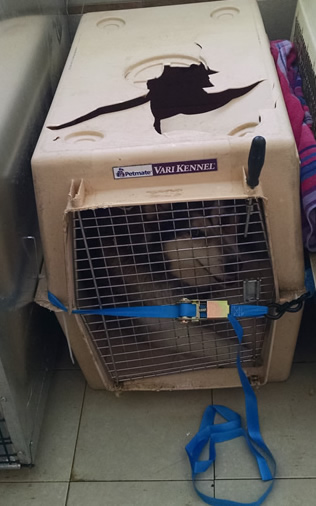
This isn't about HOW to crate train, there are articles here about that. This is about WHY you must crate train, even if you think it's silly, stupid or cruel (it's not - actually it's cruel NOT to crate train). Crates are for safety. Crates are for emotional security. They can help you potty train a young puppy. Young puppies are born with the instinct to never soil the nest. A crate uses this instinct to create a secure place he will not want to soil. So you not only get a potty trained puppy, he gets a secure and safe den he can take anywhere. Win Win.
Beyond the benefits of housetraining, a crate trained dog will see it as their own special place they know as their own, where they can store their personal toys, take a nap or where they can go to get away from things for some peace and quiet. Most dogs, once they learn what a great place a crate is, will go there just to relax and hang out.
A crate also provides safety when you can't supervise. Anyone with kids wishes they could lock the 2 year old up for an hour just to get something done. Crating your Malamute will keep them safe when you cannot supervise them for short periods of time. This is especially good for puppies and young dogs that seem to find trouble everywhere. With a crate, you can take a bath or go outside without worrying about the destruction you'll return to. It also may save you vet bills...nobody likes to discover your pup ate a sock and now you have to worry about if it'll pass.When you don't crate train a puppy, he will never be accustomed to being confined as an adult. If there were a natural disaster for example, the rescuers are not going to keep hundreds of dogs and cats in their homes running loose. It's just not possible or safe. Your dog, if found in an emergency like this will be transported IN A CRATE to a shelter where you can hopefully find each other. If you are lucky enought to leave with your dog, he will be most likely be required to be in a crate at the shelter. A dog that is crate trained, will feel safe in a crate and know he's being protected and taken care of. A dog that is not, will basically freak out and try to escape putting himself and possibly some of the other animals or humans in danger. Worst of all, if he escapes he will not be in a place where he can be fed and kept comfortable until reunited, so you may NEVER find him.
Hurricane Katrina scenarios aside, you NEED to crate train your dog. If you didn't teach him as a puppy, do it now. His life may depend on it. Emergencies happen, you may never think they will but they do. Crate training your dog gives him a sense of security when you can't be there. You can't talk to a dog and tell him I'll be back in a few days or weeks and have him actually understand. He'll just feel the anxiety of losing you, the fear you may not come back, and the confusion of having his life upside down. He may even love Uncle Bob, but it won't be home. If he learns to love a crate young, he can always have a place to feel safe and home, even at Uncle Bob's.
Crates are also good for traveling. Most dogs love car rides, but a crate reduces any stress or fear they may feel if they tend to get car sick. It also prevents them distracting the driver, or in case of an accident it stops them flying out the window or wandering off. Traveling with your dogs in crates keeps them safe because if there is ever an accident, they get the extra protection of the crate in a crash so they don't go flying around the interior of the vehicle.
When a dog is separated from his owner, either voluntarily (vacation) or by accident (emergency), he goes through a period of grief. You may think he's having a blast at daycare, but when he's not playing, he's thinking - will you be back? A dog that learns you will come back has a big advantage over dogs that never learn this. The crate is a great tool in helping them learn to be confident you will come back. It's a kind of 'security blanket' for dogs - when he learns you'll be back after short absences, he feels more confident you'll be back after longer ones. Here is the grief model we call the 7 Stages of Grief for humans - but it also applies to dogs who have been even temporarily removed from their families for any number of reasons (death, divorce, natural disaster, abandoned at shelter, long vacation, etc.)
SHOCK & DENIAL-
At first the dog is confused, and expects the owner to return shortly - as if he went to the store. He'll keep looking out windows, and becoming alert at sounds reminding him of the owner's car. Distraction provides emotional protection from being overwhelmed all at once. At this stange many dogs stop eating and will spend their time 'watching' the surroundings, trying to get their bearings. They generally do not want to play or engage other animals if they are particualarly stressed out. Lasts anywhere from a couple of days to two weeks. The time will be shorter in a familiar environment.
PAIN & GUILT-
Once the confusion wears off, and the dog is not sure when you'll be back...the dog is in pain. I suppose many wonder, what did I do to deserve this? Yes, they do think at that level becuase you are that important to them. 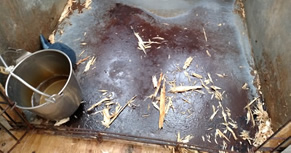
ANGER & BARGAINING-
The frustration of new circumstances they didn't expect, gives way to anger. Some dogs will scream, some will bark constantly, some will attempt to escape (even if crate trained - non-crate trained dogs are worse and DESTROY the kennel). They try to 'bargain' - which we see as them trying to get their way. "I'll only come in if I get a treat." Some stop eating briefly again in the hopes of getting attention. They become especially difficult and demanding during the times of day they may have gone for a walk, gotten a treat, were allowed to lie on the bed and get petted. They run from you when you call them, and test the fence to see if it will hold them. They are obstinate and stubborn. This is the most trying time...and can last up to two months...
"DEPRESSION", REFLECTION, LONELINESS-
Just when they seem to be getting over the anger, they become pensive. You can actualy see them pondering their previous life and what it held. They miss their owners terribly. The sadness is obvious. The solution is not wild play, but to let them just think and be. Some dogs even seem to feel emptiness or despair and refuse to play with anyone that attempts to play with them, including other dogs. Dogs that had kids take this stage particularly hard in my opinion. I remember when Shadow came back and we'd throw the ball and he had no interest. But if we threw it like a 3 year old would, he would get it and make a feeble attempt at fetching.
THE UPWARD TURN-
As they adjust to their new surroundings, they attempt to get into the new 'rountine'. They take pride in figuring out the nuances of how the new 'family' or 'kennel' or 'shelter' does things. They still do a lot of watching, but it's more active watching as they try desperately to fit in and be one of the 'pack'. If other dogs yell for dinner, they may too. They start to accept the rules and go along with them. They seem a bit less depressed and will accept some petting, but not too much, becuase the loyalty to the owner (or lost owner) is still there.
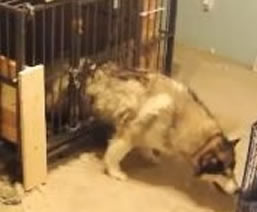
RECONSTRUCTION & WORKING THROUGH-
As he begins to fit in (knowing when dinner is, when walks happen, how the other dogs behave), he beings to really work at fitting in. He tries to cooperate more and looks forward to making a few friends (human or dog). He still misses his owner, but has accepted his fate. Ideally, a dog needs to go home at this point, particularly those in a shelter situation, or they may become depressed again due to the noise and constant commotion. This is particularly tough on dogs that were not crate trained or were only dogs. Their comfort came from the owner and they have no 'safe space' in the form of a crate, so the thought of adapting to a completely different environment with no break is daunting, and pushes some dogs back to depression.
ACCEPTANCE & HOPE-
Well adjusted, crate trained dogs eventually make it here. At this point the dog has figured out the routine - and has resigned himself to making the best of it. It may not be anything like his old home, he may not like it as much as his old home, but he adjusts and looks forward to specific times of day or playing with certain people or dogs. You begin to see joy in their eyes again. With most dogs in our experience, this takes between 2-4 months to get to this stage. A more secure, well adjusted dog gets here sooner.
If at this point, or any point along the timeline the owner returns for the dog she can expect to see joyous happiness or angry stand-offishness. The standoffishness doesn't usually last long once the dog realizes he's going HOME....Yay!!! (dogs forgive and don't dwell on the negative)
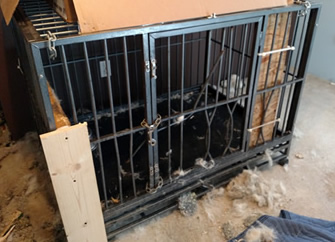 Life happens and you cannot always anticipate where it will go. We had one friend whose home was foreclosed and we had to take the dog back temporarily so he could get on his feet again. Another's spouse had an untimely accident turning their whole world upside down. Another with kids could no longer keep the dog due to extenuating health circumastances. None of these people could have anticipated the fact this would happen or that crate training would benefit their dog. From the standpoint of someone who cared for the dog, it made a HUGE difference. The dogs that were crate trained fared so much better while being away or being rehomed - even if the new home didn't use a crate much after a transition period.
Life happens and you cannot always anticipate where it will go. We had one friend whose home was foreclosed and we had to take the dog back temporarily so he could get on his feet again. Another's spouse had an untimely accident turning their whole world upside down. Another with kids could no longer keep the dog due to extenuating health circumastances. None of these people could have anticipated the fact this would happen or that crate training would benefit their dog. From the standpoint of someone who cared for the dog, it made a HUGE difference. The dogs that were crate trained fared so much better while being away or being rehomed - even if the new home didn't use a crate much after a transition period.
The crate trained dogs would retreat back into the crate when they needed some time for reflection or adjustment. The non-crate trained dogs, instead of feeling safe, became anxious and destructive. Their separation anxiety was more intense. It didn't matter what kind of crate they had at that point, if the dog wasn't crate trained as a puppy or in their home environment, they broke out of ANYTHING and risked hurting themselves in the process. One chewed the wood in the crate risking splinters in the mouth. Another bent bars and chewed metal - I'm amazed she didn't damage her teeth! While you may be ok with your own dog destroying your house, you can't expect someone watching your dog put up with this. This same dog would break out of the crate when we were gone, and tease the other dogs (who were attempting to rest quietly in their crates) and become destructive. While you may be tolerant of the occasional destruction, your friend/family/sitter is not going to be as tolerant of the dog ripping up carpeting or yanking off mouldings.
Another thought is should something happen to you is your dog adoptable? We all hope that should something happen to us, our dogs will find another good home where they can be loved like we loved them. Dogs that are not taught manners and limits are essentially unadoptable. Should anything happen to the owner the dog will be the victim of the owner's negligence and probably put down - no one wants to deal with YOUR problem. No one wants to deal with a dog that destroys the house and escapes Fort Knox! A well mannered crate trained dog has the crate to help him adjust to a new home. It buys him time to learn the rules and find comfort while he adjusts. You are really giving your dog a precious gift when you teach him a crate is a good and safe place to be when you need him to be there.








